Franky Strachan – 4 October, 2013
Though rarely short of a commission, Caravaggio's private life conjures visions of belligerence, imprisonment, brawls, vandalism and the occasional murder. However, it is his exploitation of painting as a form of armour, both a coping mechanism and mode of communication, to which The Caravaggio Gang pay homage.
The Caravaggio Gang’s 2013 annual group show is pensive with a significant twist of scepticism. 13 brings together Craig Freeborn, Philip James Frost, James Bellaney, Jay Hutchinson, Flynn Morris-Clarke, Danny Brisbane, Peter McLaren and Daniel Roberts - all fine-arts graduates who are based, or have recently been based, in Dunedin. Through working in studios within close proximity to each other and by showing in neighbouring galleries if not the same exhibitions, these eight male artists represent a strong current in the Dunedin art scene. Already socially connected, The Caravaggio Gang is creatively and perhaps philosophically united by an admiration for the enduring art of Italian painter Michelangelo Merisi (or Amerighi) da Caravaggio.
Known for his dramatic chiaroscuro and theatrical realism, this 16th century painter was hugely popular and controversial. Though rarely short of a commission, his private life conjures visions of belligerence, imprisonment, brawls, vandalism and the occasional murder. However, it is his exploitation of painting as a form of armour, both a coping mechanism and mode of communication, to which The Caravaggio Gang pay homage. While the works in this show share an element of darkness and brooding, they were created independently and curated casually - that is without a systematic plan or theoretical base. Rather than focusing on the show as a unified interpretation of a theme, which it is not, I believe it is more relevant to consider the artists’ contributions separately: as individual units brought together for a contemplative moment.
Craig Freeborn contributed two drawings and a painting - the latter, Kiss of Peace, offering the most intrigue. Usually a figurative painter who focuses on distinguishable metaphors, Freeborn has moved into the realm of abstracted, notional figures in conceptual settings. Conventionally, the kiss of peace is a Christian greeting notably used by Judas to identify and betray Jesus after the Last Supper. In Freeborn’s painting the kiss is surely brutal but while the title stems from the theological phrase, the painting is both contemporary and regionally tied.
Two isolated human forms occupy a symbolically divided pictorial space which is set against a few dislodged cultural signs (such as two bus-stops and what appears to be a shipping container). It teeters between existentialist and surrealist expressions whilst retaining an element of academicism. I was reminded of Francis Bacon’s sinister painterly graphics and soon came to connect Caravaggio’s transgressions in art and life to the violent psychological themes found in Bacon’s work - though Freeborn’s work is considerably more delicate and subdued.
On the opposite wall, Philip James Frost’s mixed-media piece What You Get is peculiar to, and typical of, this popular and highly recognizable abstract-expressionist. Characteristically bold, unframed, unformulated and gestural, Frost depicts experiences and ideas through spontaneous ciphers and colours and while this piece is not his most intricate composition, it does epitomize the exhibition’s angst-ridden undercurrent. What You Get, for me communicates deep-rooted, long brewing frustration which has been forced, in a final splurge of catharsis, onto paper - though it does not convey relief but encoded anguish; a souvenir of a particular moment or a disquieting translation of feeling. This piece is a token contribution from Frost, whose body of work outside of 13 is extensive and highly sought-after.
James Bellaney also works without premeditated structure but in an altogether different manner. One gets the impression that his work connotes a series of uninterrupted internal processes; raw emotional data not yet curbed by aesthetic platitudes. While the physicality of painting itself is the primary content of his work - the paint having been poured, dripped, flicked and allowed to pool like a midnight swamp or a coagulating wound - Bellaney’s purposeful, sensitive mark-making and compositional ingenuity suggest that these are not wholly reflexive action paintings but something more, dare I say, ‘mystical’. We are asked to connect the painting to the physical world as subjective musings dance across its surface. I was led to imagine an almighty rupture in the surface of the underworld but others might ponder synaesthesia or cosmological phenomena. Such is the breadth of Bellaney’s expression.
At the other end of the methodological spectrum is Jay Hutchinson - an artist known for painstakingly hand-stitching graffiti onto screen-printed surfaces. Hutchinson takes art-making conventions and flips them 180° to invert meaning and test boundaries whilst exploring specific perceptions - in this case “the awkward physiological progression of the male child into adolescence.” Sleeping Beauty is a picture from an adult magazine which appears to have been impetuously defaced by a scribble. But when one steps closer the line-work is revealed to be meticulous embroidery upon a finely printed sheet of cotton. Fastidiousness overrules spontaneity; the ephemeral is made permanent and notions of ‘childishness’ collapse beneath the crushing weight of sexualisation. In looking at such self referential work it is normal to react and then review your reaction before reacting again, because any terrain you cover has already been traversed and doubled-crossed by the artist in an ongoing process of self-possession and abandon - it is this tension between logic and metalogic that locks the viewer in and brings the work to life.
Complementing Hutchinson’s conceptual forays is Flynn Morris-Clarke’s How I Would Like To Love You - a grey scale pastel cinematic portrait of Marilyn Monroe complete with soundtrack and scented frame. The image is a classic if hackneyed Monroe pose but it has palpably gone through the Morris-Clarke filter to reveal her fleshy-reality and vulnerability. The audio recording is 100 minutes long hence most viewers will only hear segments of it, I heard a jazz track but was informed that the musical genres included are varied enough to include lounge music and techno. This changeability gives the presentation temporal specificity and as the smell of Prada perfume testers emanates from behind the frame, the viewer is physically drawn closer to the portrait. Murray Eskdale, gallery-owner and co-curator noted that the perfume’s potency has gradually weakened with time, to my mind adding to the temporality of the work and generating infinite metaphors of obsolescence and transience. The perfume, music and visual display together smack of voyeurism but by emphasising the immateriality of the subject matter, Morris-Clarke confidently controls and revels in the Hollywood-cliché.
Danny Brisbane also contributes to 13 in the form of portraiture with Dillinger and The Sheriff. Like Morris-Clarke his interpretations are heavily worked and psychologically perplexing. Dillinger pertains to the American bank robber of the 1930s and Brisbane has him looking reflective but not quite penitent. The vivid colours censor Dillinger’s expression by underscoring his troubled gaze with vibrant defiance. Regarding The Sheriff, I am not sure to which agent the artist specifically refers but The Texas Chainsaw Massacre (2003) example springs to mind at once followed by his appalling abuses of power and deeply sinister (yet utterly fascinating) intentions. In The Sherriff and Dillinger, therefore, Brisbane comfortably dabbles in both sides of the law using his nimble brushwork and tonal sensitivity to endow the officer with criminal intent and the robber with conservativism. The artist underscores the humanity (or lack thereof) within his subjects by using a painterly finish to stress the façadism of appearances and this, I feel, is the muscle of these works.
The final two artists to be mentioned here are Peter McLaren and Daniel Roberts. McLaren presented two monotypes which appear like Turner-esque seascapes. They are romantic and temperamental and offer the quietest contributions to the exhibition. This is a good thing. Neatly framed, lyrical and pleasantly dreamy they are works to become lost within. In an exhibition so full of colour and deviant characters McLaren’s prints provide a visual and psychological interlude. I am surprised that the Caravaggist context does not imbue these interpretational compositions with foreboding since they could easily evoke the tumult of Turner’s Slavers Throwing Overboard the Dead and Dying, Typhoon Coming On (1775-1851) or Paul Nash’s Totes Meer (Dead Sea) (1940-41) - perhaps it has to do with McLaren’s remarkably light touch and fine tonal inflections, perhaps it was just my mood. They are sophisticated monotypes which feel as complete as they do mysterious.
Daniel Roberts presented two untitled sculptures in the basic form of wooden chairs. One is completely covered in screws and the other is patiently etched out and carved down to a fragile, unusable state. Both are incredibly tactile, alluring, labour-intensive works, in front of which the natural response is a desire to sit, though one resists - or do they? Tempting fate the etched chair was indeed sat upon during the opening night to a theatrical and disruptive end. It now lies in a broken state surrounded by the irreparable fragments of its former self. Prior to being informed of the breakage I had read the two sculptures as a single installation. Laboriously carved Untitled A‘s stark contrast to its sturdy looking, hardware laden counterpart (Untitled B) presented, so I thought, a Caravaggistic reference to endurance and fragility, skirmish and stagnancy, passivity and dissent. Perhaps it is none of these things. What is certain though, is that Roberts’ admirable decision to exhibit his freshly broken sculpture effectively sums up the relaxed ‘it-stands-or-falls-as-it-is’ attitude of the whole exhibition. I will finish by mentioning that 13 opened on Friday the 13th to reveal 13 independent works, adding a wry and very satisfying edge to this already self-conscious and shadowy exhibition.
Franky Strachan
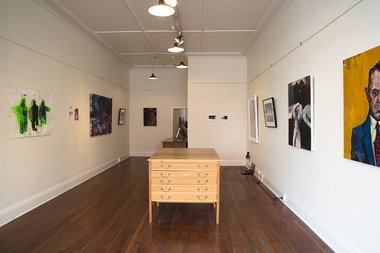

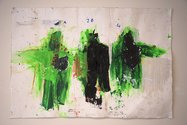


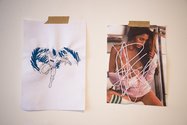



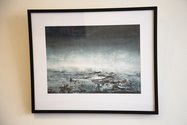
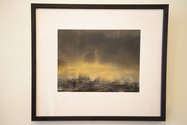


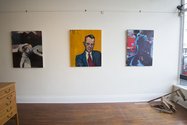
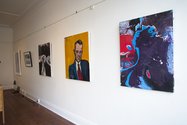
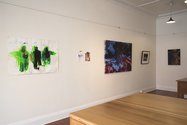
 Advertising in this column
Advertising in this column Two Rooms presents a program of residencies and projects
Two Rooms presents a program of residencies and projects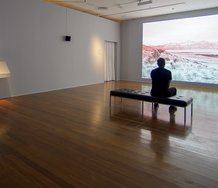
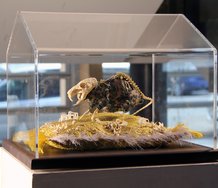
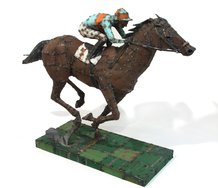
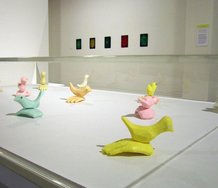
This Discussion has 0 comments.
Comment
Participate
Register to Participate.
Sign in
Sign in to an existing account.